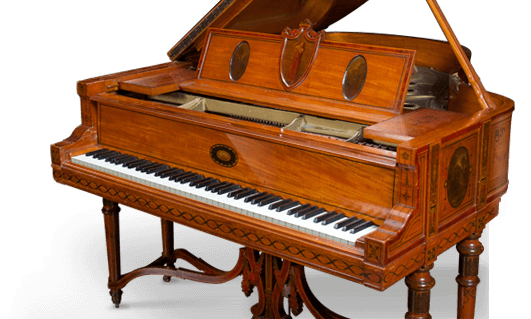
Buying a piano is a big decision. Most people will only do it a handful of times in their life, if at all. At Lindeblad, we buy and sell pianos every day. Here we have compiled some information that will make the piano buying process a little easier. Of course, if you have any questions our friendly piano experts are always happy to help.
 New pianos are often the natural place to start shopping for an instrument. There is a wide selection, and low likelihood of encountering unwanted surprises in quality. The compromise with new pianos comes in their price, which will be a premium. Generally, the price will be a good indicator of quality. Lower priced pianos will typically be mass-produced, very likely employing cheaper materials such as plastics in the mechanics, and formed-particle woods in the case. These pianos are engineered to last only a couple of decades. Hand crafted pianos made from high quality materials and hardwoods, by comparison, fetch the highest prices and will last many generations.
New pianos are often the natural place to start shopping for an instrument. There is a wide selection, and low likelihood of encountering unwanted surprises in quality. The compromise with new pianos comes in their price, which will be a premium. Generally, the price will be a good indicator of quality. Lower priced pianos will typically be mass-produced, very likely employing cheaper materials such as plastics in the mechanics, and formed-particle woods in the case. These pianos are engineered to last only a couple of decades. Hand crafted pianos made from high quality materials and hardwoods, by comparison, fetch the highest prices and will last many generations.
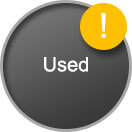 The attraction of these pianos is the potential of finding a high quality piano at a much lower price than if it was new. This is particularly true when shopping for premier brands, such as Steinway, because these pianos have been built to last.
The attraction of these pianos is the potential of finding a high quality piano at a much lower price than if it was new. This is particularly true when shopping for premier brands, such as Steinway, because these pianos have been built to last.
The risk in shopping for used pianos is in the variability of their quality. Deficiencies may have appeared over the decades of a piano's lifetime, many of which may not be apparent, even to the seller. For this reason it is important to buy a used piano from a reputable dealer that can offer (and support) a warranty. Otherwise we encourage you to enlist the help of an expert who can inspect any used piano you are considering.
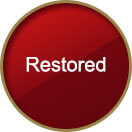 This third option is a surprise for many first time piano shoppers. An older high-end piano, restored by a reputable company, combines the quality and longevity of old world hand craftsmanship, with the cost savings of a used or entry-level new piano. In a fully restored piano, all of the parts vulnerable to age have been replaced with new parts. The cabinet has been completely refinished and shines like new. A restored piano will look, sound, and feel like a new piano. But there is a considerable cost savings, because there was no need to manufacture major components such as the cast iron harp, the hardwood cabinet, or the support structures. Those parts are re-used, since they are exceedingly durable.
This third option is a surprise for many first time piano shoppers. An older high-end piano, restored by a reputable company, combines the quality and longevity of old world hand craftsmanship, with the cost savings of a used or entry-level new piano. In a fully restored piano, all of the parts vulnerable to age have been replaced with new parts. The cabinet has been completely refinished and shines like new. A restored piano will look, sound, and feel like a new piano. But there is a considerable cost savings, because there was no need to manufacture major components such as the cast iron harp, the hardwood cabinet, or the support structures. Those parts are re-used, since they are exceedingly durable.
 The easiest way to assess the quality of a prospective piano is to work with a reputable restorer or dealer of fine pianos. They will listen to your unique needs and requirements and be able to recommend pianos that are a good match for your needs. They will be able to discuss freely the pros and cons of any specific piano in their inventory. Beyond that, here are some key things to check on any piano to help judge its quality.
The easiest way to assess the quality of a prospective piano is to work with a reputable restorer or dealer of fine pianos. They will listen to your unique needs and requirements and be able to recommend pianos that are a good match for your needs. They will be able to discuss freely the pros and cons of any specific piano in their inventory. Beyond that, here are some key things to check on any piano to help judge its quality.
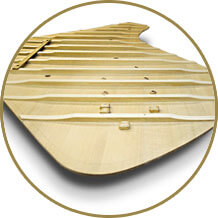 The most important aspect of a good soundboard is the "crown" — the slight upward curve from the edges in towards the center. In addition, the soundboard should be made of tight-grained spruce, at least 12-14 grains per inch. For new pianos: no cracks should be present on the soundboard. For used pianos: very slight cracks between the individual planks comprising the soundboard are ok, as long as you are satisfied with the piano's overall sound, and you hear no buzzing. Extensive cracking, especially within the planks can be a bad sign. A used piano's soundboard can be replaced during restoration.
The most important aspect of a good soundboard is the "crown" — the slight upward curve from the edges in towards the center. In addition, the soundboard should be made of tight-grained spruce, at least 12-14 grains per inch. For new pianos: no cracks should be present on the soundboard. For used pianos: very slight cracks between the individual planks comprising the soundboard are ok, as long as you are satisfied with the piano's overall sound, and you hear no buzzing. Extensive cracking, especially within the planks can be a bad sign. A used piano's soundboard can be replaced during restoration.
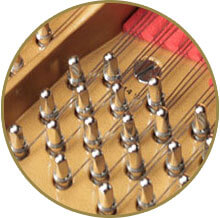 Premier quality blocks are made from multiple layers of a hardwood, such as maple. The block must be fresh and strong enough to maintain a tight grip on the tuning pins, so that the piano holds a tune.
Premier quality blocks are made from multiple layers of a hardwood, such as maple. The block must be fresh and strong enough to maintain a tight grip on the tuning pins, so that the piano holds a tune.
 The cast iron harp that holds the strings in place should be free from cracks. Pay particular attention when inspecting older pianos and pianos longer than 6 feet as they are more likely to have cracks. These cracks can be covered with paint so look closely at the harp, particularly at the front around the pin block, just behind the keyboard.
The cast iron harp that holds the strings in place should be free from cracks. Pay particular attention when inspecting older pianos and pianos longer than 6 feet as they are more likely to have cracks. These cracks can be covered with paint so look closely at the harp, particularly at the front around the pin block, just behind the keyboard.
 The strings should show no signs of rust.
The strings should show no signs of rust.
 On a new piano, keys are rarely a reason for concern. On a used piano, keys should be level along their tops, and even along their front edges. They should be free of chips or gouges. Vintage piano ivory keys should be white as possible. A quick way to tell if keys might be ivory is to look for a seam right at the point where the black keys end. Ivory keys will have a seam.
On a new piano, keys are rarely a reason for concern. On a used piano, keys should be level along their tops, and even along their front edges. They should be free of chips or gouges. Vintage piano ivory keys should be white as possible. A quick way to tell if keys might be ivory is to look for a seam right at the point where the black keys end. Ivory keys will have a seam.
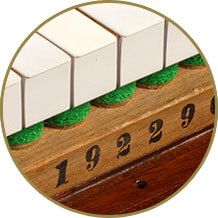 All felts on the piano should be fresh, bright and springy. Dingy, hard, compressed felts can greatly reduce a piano's playability, and reduce the quality of its sound. If the piano is more than 70 years old, the felts almost certainly need to be replaced.
All felts on the piano should be fresh, bright and springy. Dingy, hard, compressed felts can greatly reduce a piano's playability, and reduce the quality of its sound. If the piano is more than 70 years old, the felts almost certainly need to be replaced.
 The cabinet is made from hard structural wood under a thin veneer. On used pianos, there should be absolutely no damage to the structural wood, whether the legs, lid, or main cabinet. Damage to the veneer may be unacceptable if you greatly value the pianos' appearance, and should reduce the piano's price in any case.
The cabinet is made from hard structural wood under a thin veneer. On used pianos, there should be absolutely no damage to the structural wood, whether the legs, lid, or main cabinet. Damage to the veneer may be unacceptable if you greatly value the pianos' appearance, and should reduce the piano's price in any case.
PROS
CONS
PROS
CONS
Additional notes: Lindeblad Piano Restoration scours online marketplaces such as Ebay and Craigslist to acquire pianos for restoration for our own inventory. Because of this, we have extensive experience with what to expect when buying pianos from private parties. Our experience is that it is very rare to find a competitively priced used piano on Ebay or Craigslist which does not require major work. A private customer without the expertise and resources of a restoration company could easily get stuck with a disappointing piano.
PROS
CONS
A piano is a large investment. Whether you purchase one from a traditional dealer, an individual seller, or Lindeblad, we encourage you to do your research. Here are the questions to ask.
Does the piano come with any warranty? What exactly does the warranty cover, and for how long? How will warranty issues be handled, by the seller, or a third party?
Does the seller offer a return policy if the piano turns out to have insurmountable problems?
If you cannot visit the piano, does the seller offer a comprehensive selection of photos? Sellers often provide only photos that were convenient to take without moving the piano. Be sure that you can clearly see the entire piano. Do not hesitate to ask for additional photos or photos with better lighting.
What is the piano's serial number? The serial number can allow you to independently research the background of the piano. For instance, with a Steinway's serial number, you can request an official letter from Steinway verifying the original date of manufacture and sale, and possibly any subsequent repairs or service that were performed by Steinway.
Does the seller offer any opportunity to customize the piano before sale? This is rarely offered unless the seller has access to restoration facilities. But customization affords you the opportunity to have the piano's tone adjusted to your preferences, to have it refinished in the exact color of your choosing, or have any number of other features changed to your specification.
Who handles shipping the piano, and the costs involved? Are you expected to organize moving the piano? Is the cost of shipping included in the price? Pianos are hardy instruments that can gracefully withstand being transported, assuming they are correctly prepared and loaded using the appropriate gear. To ensure the best handling, specialized piano movers should perform the transportation.
What is the seller's reputation? For private online sales, this can be difficult to establish. But it is still worth doing a little online searching to see if anyone else has dealt with the seller, and what the result was.
Piano manufacturers often produce a variety of models. With grand pianos, these models usually represent the different lengths, ranging from about 5 feet, up to 9 feet. The width is almost uniform regardless of the model. This is because keyboard size has effectively become standard.
For example, Steinway's models correspond to lengths as follows:
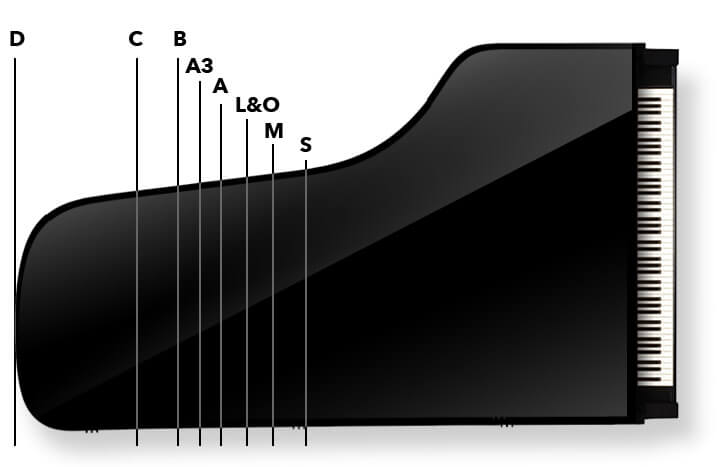
D - 8' 11" | C - 7' 5" | B - 6' 10.5" | A3 - 6' 4.5" | A - 6' 1" or 6' 2" | L - 5' 10.5" | O - 5' 10" | M - 5' 7" | S - 5' 1"
The length of the piano primarily affects its sound. A longer soundboard has more vibrational area. Longer bass strings generate more energy and a fuller sound.
The style of the piano refers to the style of adornment on the cabinet and legs. Essentially, what it looks like as a piece of furniture. Style has no bearing on the musicality of the piano.
Most pianos are made in the traditional style. Pianos that are not in the traditional style are broadly referred to as "art case" because their cabinets are artfully adorned. Art case styles usually follow a standard pattern established by each piano maker, and have have changed very little over time. These pianos are generally more expensive than equivalent traditional style pianos because of the greater amount of workmanship and their relative scarcity.
Some art case pianos are actually designed and executed by an artist. These pianos are usually unique or produced in extremely limited runs. Highly desirable art case pianos can command very high prices.
The following styles are the most common:
This is the classic, unadorned look, and is the most common style of piano, particularly over the last several decades.

Victorian pianos have a moderate amount of carved adornment on the cabinet and lid. The legs are carved in one of several horizontally symmetrical patterns.
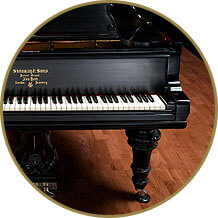
These pianos have more elaborate and extensive carvings. The legs have graceful, asymmetrical curves and ornamentation.

A piano's cabinet is made by layering strong wood. These layers are then temporarily softened and shaped into the elegant and instantly recognizable curves of a grand piano. These form the support and structure of the piano. The structural wood is then overlaid with a thin veneer of attractive wood such as mahogany, or walnut. In some cases this veneer employs exceptionally rare woods or artisanal techniques. The veneer of most piano cabinets can be refinished during restoration to match your preferences.
